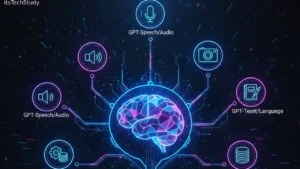Introduction: The Entertainment Revolution Inside Your Living Room
Remember when watching TV meant flipping through cable channels, adjusting antennas, and dealing with countless wires? Those days are long gone. The living room has transformed into a digital hub powered by Smart TVs and streaming platforms that deliver high-quality, on-demand entertainment.
From AI-driven recommendations to 8K resolution displays, technology is reshaping how we consume content. As of 2025, streaming platforms like Netflix, Disney+, Amazon Prime Video, and YouTube TV are competing fiercely—not just for subscribers but for technological superiority. Meanwhile, Smart TVs are becoming smarter than ever, integrating with IoT ecosystems, voice assistants, and personalized user profiles that adapt to our tastes and lifestyles.
This shift isn’t just about convenience; it’s a technological evolution that’s redefining the very nature of home entertainment. But what powers this transformation, and where is it heading next? Let’s dive deeper into the tech behind the screen and uncover how Smart TVs and streaming platforms have evolved—and what’s coming next.
The Rise of Smart TVs: A Brief History
From Dumb Screens to Intelligent Displays
When the first Smart TVs appeared around 2007, they were revolutionary. For the first time, users could connect their TVs to the internet, browse YouTube, and access simple apps. Fast forward to 2025, and Smart TVs now come with built-in AI processors, cloud gaming capabilities, 4K and 8K HDR displays, and seamless app ecosystems.
Smart TVs have evolved from passive receivers into interactive media centers capable of handling multiple entertainment and productivity tasks. With voice control, gesture recognition, and personalized dashboards, your TV is no longer just for watching—it’s a full-fledged connected smart device.
Key Technologies Powering Modern Smart TVs
| Technology | Description | Impact on User Experience |
|---|---|---|
| AI & Machine Learning | Powers personalized content recommendations, voice recognition, and adaptive brightness. | Enhances engagement and ease of use. |
| 8K & OLED Displays | Offers ultra-high definition visuals and superior contrast ratios. | Delivers cinematic picture quality. |
| Quantum Dot Technology (QLED) | Uses nanoparticles for more accurate color reproduction. | Produces vibrant, realistic colors. |
| IoT Integration | Connects TV with other smart devices like lights, thermostats, and speakers. | Enables a unified smart home ecosystem. |
| Edge Computing | Processes data locally for faster response times and privacy protection. | Improves streaming performance and reduces latency. |
These innovations are not just making screens prettier—they’re making them smarter, faster, and more responsive to user needs.

Streaming Platforms: The Backbone of Modern Entertainment
From Cable to Cloud: How Streaming Changed the Game
Once upon a time, viewers were tied to broadcast schedules and cable boxes. Now, streaming platforms have liberated audiences, offering on-demand, personalized entertainment. With platforms like Youtube app, Netflix, Hulu, Prime Video, and Apple TV+, the control has shifted from broadcasters to viewers.
The evolution of streaming isn’t just about access—it’s about intelligence. Algorithms analyze your viewing habits to recommend what you’ll love next. AI-driven compression technologies ensure 4K and 8K content streams smoothly even on average internet speeds, while cloud servers deliver content worldwide with minimal lag.
How AI and Data Are Redefining Streaming
Artificial Intelligence lies at the heart of modern streaming services. From recommendation engines to adaptive bitrates, AI ensures you get a seamless and personalized experience.
AI in Streaming Platforms: Key Roles
- Recommendation Algorithms: Suggests content based on your viewing history, time of day, and preferences.
- AI Compression: Reduces data usage while maintaining video quality for smoother streaming.
- Voice Search Integration: Lets users search by talking—no remote required.
- Predictive Buffering: Anticipates what you’ll watch next, loading content in advance.
These advancements create a fluid, intuitive experience, blending technology and entertainment seamlessly.
Smart TVs vs. Streaming Devices: Which One Should You Choose?
While Smart TVs integrate streaming features directly into the display, standalone streaming devices like Roku, Fire TV Stick, Google Chromecast, and Apple TV 4K still hold strong appeal. Here’s a quick comparison:
| Feature | Smart TVs | Streaming Devices |
|---|---|---|
| Setup | Plug-and-play, built-in apps | Requires HDMI connection |
| Performance | Varies by brand and model | Consistent across devices |
| Upgradability | Limited to firmware updates | Easily replaceable |
| Price | Higher upfront cost | More affordable |
| App Availability | Preloaded with major apps | Wider, frequently updated ecosystem |
Pros of Smart TVs
- All-in-one entertainment solution
- No extra hardware required
- Integrated with AI assistants (Google Assistant, Alexa, Bixby)
- High-end display technology (OLED, QLED, Mini-LED)
Cons of Smart TVs
- Expensive upgrades
- Slower performance over time
- Limited customization
Pros of Streaming Devices
- Affordable and portable
- Regular software updates
- Compatible with any HDMI TV
- Easy to replace or upgrade
Cons of Streaming Devices
- Requires additional setup
- Dependent on TV’s resolution and port availability
The Role of 5G and Cloud Technology in Streaming
As 5G networks expand, they are drastically improving how we stream. With lower latency and higher speeds, users can enjoy 4K and 8K streaming, cloud gaming, and multi-device synchronization effortlessly.
Cloud technology further enhances this by enabling platforms like Google Stadia and NVIDIA GeForce Now to stream games directly on Smart TVs—no console required.
Together, 5G + Cloud equals instant access to ultra-high-quality content from anywhere, reducing buffering and making entertainment smoother than ever. Learn More About 5G
Smart TV Ecosystems: More Than Just Entertainment
Modern Smart TVs are becoming central command hubs for smart homes. Through IoT integration, they can:
- Display security camera feeds
- Control smart lighting
- Adjust room temperature via voice commands
- Sync with smartphones for cross-device continuity
Manufacturers like Samsung (SmartThings), LG (ThinQ), and Sony (Bravia XR) are leading the way, creating cohesive ecosystems that bridge entertainment and home automation.
Challenges and Concerns
While the future of Smart TVs and streaming platforms looks bright, there are still hurdles to overcome:
- Privacy Risks: Data collection and microphone-based controls raise security concerns.
- Software Fragmentation: Different platforms (Tizen, WebOS, Android TV, Fire OS) make updates inconsistent.
- Subscription Overload: Multiple streaming services can lead to higher monthly costs.
- E-Waste and Sustainability: Frequent upgrades contribute to electronic waste.
Addressing these challenges will be crucial to making smart entertainment both sustainable and user-friendly.
The Future of Smart TVs and Streaming: What’s Next?
By 2030, expect to see TVs that are:
- AI-native: Fully adaptive to user mood and context.
- Voice-first and Gesture-Controlled: No remotes, just natural interaction.
- 8K Standardization: As prices fall, 8K will become mainstream.
- Holographic and Foldable Displays: Redefining the concept of “screen.”
- Integrated Gaming and Work Platforms: Turning TVs into hybrid productivity tools.
The boundary between television, computer, and smartphone is blurring fast—and soon, your TV may be your all-in-one entertainment, work, and communication hub.
Conclusion: Smarter Screens, Smarter Living
The evolution of Smart TVs and streaming platforms marks a defining moment in digital entertainment. What started as a luxury has become a necessity in modern households, blending AI, IoT, and 5G to deliver immersive, connected experiences.
As technology continues to evolve, our screens will not only entertain us but understand us—anticipating our preferences, simplifying our routines, and making our homes more intelligent than ever.
In the end, the future of entertainment is not just about what we watch—but how technology makes that experience seamless, personal, and smart.
FAQs: Everything You Need to Know
Q1: What makes a Smart TV different from a regular TV?
Ans: A Smart TV connects to the internet, allowing you to stream content, browse the web, and install apps—unlike a traditional TV that relies solely on cable or HDMI input.
Q2: Are streaming devices still worth it in 2025?
Ans: Yes. Streaming devices like Roku, Chromecast, and Fire Stick are great for upgrading older TVs, offering faster performance and newer app versions at a lower cost.
Q3: What is the best Smart TV OS?
Ans: It depends on user preference. Google TV offers the best app ecosystem, Tizen (Samsung) focuses on integration, and WebOS (LG) provides a clean, user-friendly interface.
Q4: How does AI improve streaming experiences?
Ans: AI personalizes recommendations, adjusts playback quality automatically, and enhances voice recognition, creating a seamless and engaging viewing experience.
Q5: Is 8K worth it right now?
Ans: While 8K TVs offer unmatched clarity, most content is still 4K or lower. However, AI upscaling is bridging the gap, making 8K TVs a good long-term investment.
Q6: Are Smart TVs secure?
Ans: Most are, but always update firmware, use strong passwords, and disable unnecessary voice/mic permissions to enhance privacy.












No Comments Yet
Be the first to share your thoughts.
Leave a Comment